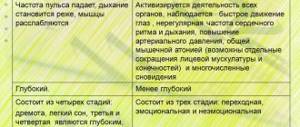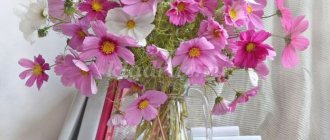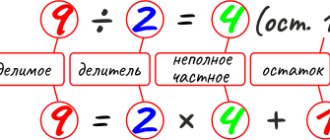Lesson Mushrooms 5th grade
— The study of the kingdom of mushrooms, which includes at least 100 thousand species, is carried out by the science of mycology (“mikos” - mushroom, “logos” - science), which arose at the end of the 19th century, the founder of which was the Russian scientist F.M. Kamensky.The most famous among mushrooms are cap mushrooms.
-Why do you think they got this name?
-Let's get acquainted with the structure of cap mushrooms during the laboratory work “Structure of cap mushrooms.”
(Hands out dummies of mushrooms.)
- Look at the models of mushrooms and name the main parts of the mushroom (children’s answers).
(The teacher shows the structure of cap mushrooms, using a presentation, dummies of mushrooms, and summarizes the students’ answers.)
— The mushroom consists of a stem, a cap, they form a fruiting body, which consists of mycelium. The main part of the mushroom is the mycelium. It is located underground and occupies large areas. Sometimes several hundred hectares! The symbiosis of mycelium with tree roots is called mycorrhiza. Its cells are binucleate and do not contain plastids. The fruiting body develops on them.
Pay attention to what is under the mushroom cap (tubes and plates). Cap mushrooms are divided into tubular (boletus, boletus, white mushroom) and lamellar (milk mushroom, honey mushroom, saffron milk cap). The tubes and plates contain spores, with the help of which mushrooms reproduce.
-Mushrooms have been known to people for a very long time; they were eaten in ancient times. In Rus', mushrooms were not only collected by peasants; they were also served on the royal table. In their chemical composition, mushrooms are close to vegetables and animal products. Mushrooms contain vitamins and microelements. There is twice as much protein in dried mushrooms as in beef and three times as much as in fish.
Properly prepared mushrooms are tasty and healthy. This shows how unusual the mushrooms are.
-Tell me, what is the difference between a chanterelle and a fly agaric? (edible and poisonous).
-On the slide from the list, write down edible mushrooms in one column and poisonous mushrooms in the second.
Based on the results of the self-test, we conclude that it is necessary to clearly know which mushrooms are edible and which are poisonous.
-What other rules should you know when picking mushrooms? Let's try to formulate the basic rules for picking mushrooms.
1. You cannot knock down unfamiliar and inedible mushrooms - they are used to treat animals.
2. You cannot pick mushrooms along the roads, they accumulate harmful substances.
3. It’s better not to take an unfamiliar mushroom!
4. Cut the fruiting body with a knife or carefully twist it so as not to damage the mycelium.
5. You cannot cut very large and old mushrooms; they contain many harmful substances and can cause poisoning.
I have prepared instructions for you on first aid for mushroom poisoning. (distributed to each student).
-We listen to a message about the role of mushrooms in nature and for humans and conclude that we have learned something new about mushrooms.
So, the world of mushrooms is vast and diverse. But not all mushrooms have a cap and a stem.
The kingdom of mushrooms includes fungi that live on trees - tinder fungi. But there is another group of mushrooms that can only be seen under a microscope - these are microscopic mushrooms. People are often unaware of their existence. They look like films, crusts, loose and powdery deposits of spoiled food products, rotten leaves, and rotten wood. They are called mold. There is another type of microscopic mushrooms, without which a person cannot bake bread, make wine, kvass - yeast. Yeast can convert sugar into alcohol and carbon dioxide. They do not form mycelium. Unlike others, they grow as single cells.
Lesson summary “The Kingdom of Mushrooms” 5th grade Federal State Educational Standard
Methodological development of the lesson Topic: “The Kingdom of Mushrooms” For 5th grade Prepared by: Bashmakova Larisa Vyacheslavovna, biology teacher of private secondary school No. 1 Art. Novotitarovskaya 2020 Technological map of the lesson Lesson topic: Kingdom of Mushrooms Class: 5 Teacher: biology Bashmakova L.V. Lesson type: “discovery” of new knowledge Content goals: educational: familiarize students with information about the kingdom of mushrooms. developing: developing students’ ability to plan their activities, the ability to act according to a model. educating: developing students’ motivation for learning and cognitive activity. Planned results of the training session: Subject: to know - the characteristics of the kingdom of mushrooms, the differences and similarities of mushrooms from plants and animals, definitions: symbiosis, mycorrhiza, spores To be able to - distinguish poisonous mushrooms from edible ones, find a place in nature where mushrooms grow, distinguish mutually beneficial ones in nature relationships Meta-subject: Regulatory: the ability to set lesson goals, plan the course of one’s activities upon achieving a result, self-control, self-esteem. communicative: the ability to communicate directly in a group, the ability to ask questions cognitive: the ability to extract information and work according to an algorithm, make comparisons Personal: the formation of motivation for learning and purposeful activity, readiness for self-development Technology used: ICT, problem-based learning, semantic reading, learning technology cooperation. Information technology resources: textbook, workbook, computer, projector, presentation for the lesson, video about mushrooms, collection of mushrooms, microscope, microscopic specimen of mold fungi, living object - mucor mushroom Lesson stages
Stage tasks
Teacher activities
Student activities
UUD
stage of motivation (self-determination) for educational activities
Create a favorable psychological mood for work
Greeting, checking preparedness for the lesson. Statement of the problem in the form of showing a presentation about mushrooms (mold, yeast, cap mushrooms) with interesting facts.
Greeting from the teacher. View the presentation. Formulate the intended topic of the lesson. What goals will be addressed during the lesson?
Personal UUD
Be able to motivate yourself for purposeful cognitive activity, Communicative UUD. Be able to express your thoughts orally.
Cognitive UUD. Be able to convert information from one form to another
stage of actualization and trial educational action;
Updating basic knowledge and methods of action
The teacher asks the students questions: What will we talk about in class today? What is special about these organisms? Are fungi similar to other organisms? How? Is it possible to separate mushrooms into a separate kingdom?
Reproduce existing knowledge about animals and plants. Synthesize existing knowledge and apply it for comparison.
Cognitive UUD. Be able to provide evidence of facts.
Communicative UUD. Be able to express your thoughts orally
the stage of identifying the location and cause of the difficulty;
Ensuring children are motivated to learn and accept lesson goals
Offers to plan work in the lesson.
Formulate the topic of the lesson, the purpose of the lesson. Plan their work in class
Regulatory UUD
Ability to set goals and plan activities
stage of constructing a project to get out of a difficulty;
Involving students in purposeful activities
Organizes student activities:
In the textbook on page, study the material about the kingdom of mushrooms, study the diagrams, illustrations in the textbook.
Organizes the work of students with a microscope, distributes a living object (mold).
While students are working, as necessary, answers students’ questions and helps with the preparation of microslides.
They work with text, illustrations, diagrams in the textbook.
A microscopic specimen of a mold fungus is prepared and examined under a microscope.
Cognitive UUD.
Ability to work with information, semantic reading. Performing an educational and practical task. Work according to the algorithm
Communicative UUD. Be able to express your thoughts orally when asking questions.
stage of primary consolidation with pronunciation in external speech;
Ensuring children’s perception, comprehension and primary memorization of the topic being studied:
Answer the questions at the end of the paragraph.
On the computer, in the “Mushrooms” folder, in the document “Classification of the Fungal Kingdom,” invites students to study the material to fill out the table in the workbook on p.
During student work, answers student questions as needed.
They work with text, illustrations, diagrams in the textbook. Establish a correspondence between the text and illustrations.
They study the document, analyze the information, and make notes in a notebook.
Cognitive UUD.
Ability to work with information, semantic reading, ability to analyze, compare. Computer skills.
Communicative UUD. Be able to express your thoughts orally when asking questions. Ability to work in pairs (communication).
stage of independent work with self-test according to the standard
Identification of the quality and level of assimilation of knowledge and methods of action, as well as identification of shortcomings in knowledge and methods of action, establishing the causes of identified shortcomings
Offers students tasks for independent work:
A basic level of:
Test on the topic “Kingdom of Mushrooms”
1. Fungi - widely distributed in the soil... (water, living organisms, dead remains on tree trunks on the surface of metal and rubber products).
2. In mushrooms, the reserve nutrient is... (glycogen), and in plants... (starch).
3. The science that studies mushrooms is called... (mycology).
4. The vegetative body of a mushroom is a complex interweaving of thin, branching threads, which are called ... (hyphae), and in total these threads make up ... (mycelium) of the fungus, or its mycelium.
5. Yeast reproduces by... (budding).
6. Mushrooms are not capable of photosynthesis because their cells do not contain... (chlorophyll).
7. Penicillium is used in medicine to produce... (penicillin).
8. The fruiting body of a cap mushroom consists of... and... (cap and stump).
9. Mushrooms reproduce in three ways... (vegetative, asexual, sexual).
10. Based on their feeding method, mushrooms can be divided into two groups... (saprophytes and parasites).
11. For the growth of mycelium, the presence of air is necessary... (moisture, heat).
12. The mutually beneficial relationship between two organisms: a mushroom and a tree is called... (symbiosis).
13. In the fight against parasitic fungi they use... (pesticides).
14. Mushrooms are used...
Let our magazine have a page with which other students can test their knowledge on this topic - a test that I offer you too.
When students check test items, it helps to identify and eliminate deficiencies
Perform the test yourself. Check the test answers using the keys. They give a grade for the work performed (in accordance with the criteria), then carry out mutual evaluation.
When completing basic level tasks, they move on to advanced level tasks.
Cognitive UUD.
Ability to work according to an algorithm, analyze the information received, and draw conclusions.
Regulatory UUD
Ability to monitor and correct one’s activities
Communicative UUD. Ability to work in pairs (communication).
stage of inclusion in the knowledge system and repetition;
Provide qualitative assessment of the work of the class and individual students
To correct the results obtained in the previous stage, the children are offered tasks of basic (Appendix 1 or 3) and increased (Appendix 2) levels of difficulty.
Complete the assigned tasks. Carry out self-check and mutual check (using the proposed keys)
Cognitive UUD.
Ability to work according to an algorithm, analyze the information received, and draw conclusions.
Regulatory UUD
Ability to monitor and correct one’s activities
Communicative UUD. Ability to work in pairs (communication), proficiency in oral and written language
Homework information
Ensuring that children understand the purpose, content and methods of completing homework
Assigns homework to students who have completed only the basic level assignments and have made serious mistakes in the advanced level assignments.
Paragraph, learn terms from the dictionary of a young mycologist.
Write down homework in a diary and ask questions that interest them.
stage of reflection of educational activities in the lesson.
Initiate children's reflection on their own activities and interactions with the teacher and other children in the class
Organizes reflection:
1.Distributes a self-assessment sheet (Appendix 5) to students to fill out
2. Discusses their grades with students and adjusts students' grades.
They fill out a self-assessment sheet and announce their grade.
Ask questions to the teacher.
Personal UUD
Readiness for personal self-determination, self-assessment based on the criterion of successful educational activities.
Communicative UUD. Be able to express your thoughts orally and ask a question.
Regulatory UUD
Ability to evaluate the correctness of an action at the level of adequate assessment
Annex 1.
Appendix 2.
Appendix 3
Appendix 4.
Dictionary of a young mycologist
1. Mushrooms are nuclear multicellular organisms whose body consists of numerous threads.
2. The mycelium consists of long binuclear cells, does not contain chlorophyll, tightly adjacent threads form the fruiting body of the fungus. The main part of each mushroom, the fruiting bodies develop on it.
3. Mushroom root is a tightly entwined tree root with mycelium threads; the mycelium can even grow into the root of the tree.
4. Hyphae are thin branching threads that make up the vegetative body of the fungus.
5. Smut is a parasitic fungus that destroys grains and turns them into black dust. The spikelets become like charred firebrands.
6. Yeasts are microscopic fungi that reproduce by budding and live in a nutrient medium rich in sugar.
7. Mycology is the science that studies mushrooms.
8. Mycorrhiza – otherwise fungal root.
9. Mycelium – otherwise mycelium.
10. Mukor is a mold fungus, the body consists of one very overgrown cell.
11. Parasites are organisms that feed on organic substances of living organisms.
12. Penicillus is a mold that is bred to produce medicine.
13. Penicillin is a waste product of a mold fungus and has bactericidal properties.
14. Fruiting body - formed by a cap and a stalk, typical for cap mushrooms.
15. Saprotrophs are organisms that obtain organic substances from dead organisms or secretions of living organisms.
16. Symbiosis is a mutually beneficial relationship between two organisms - a mushroom and a tree.
17. A spore is a specialized cell used by fungi for reproduction.
18. Ergot is a parasitic fungus that turns grains into black-purple horns and can cause severe poisoning if it enters the human body with food.
19. Polypore is a parasitic fungus that shortens the life of trees; the fruiting bodies are perennial.
20. Chitin is a substance that is part of the cell wall of fungi.
.






